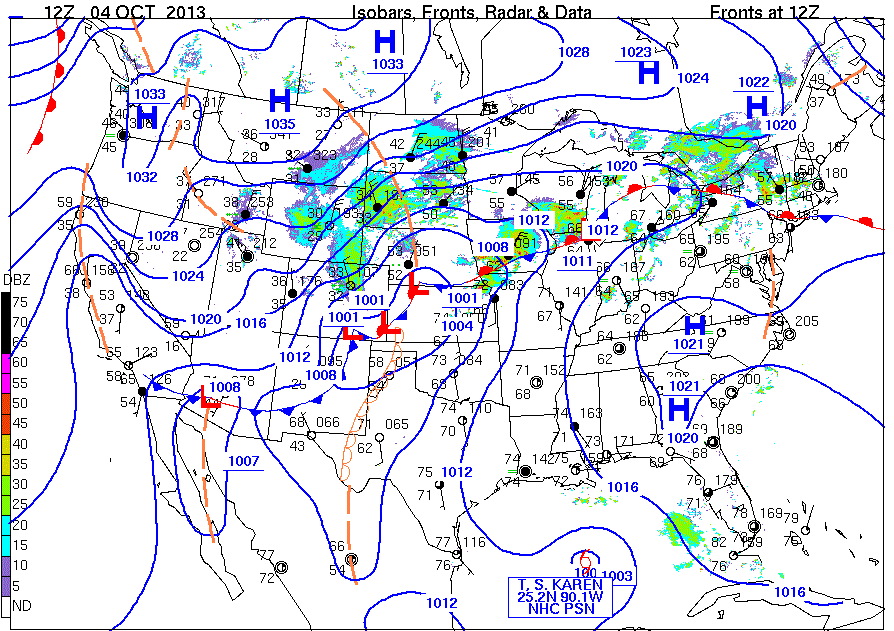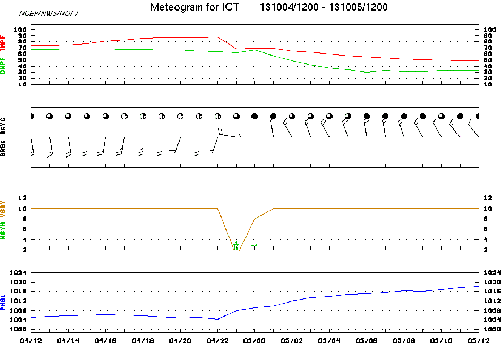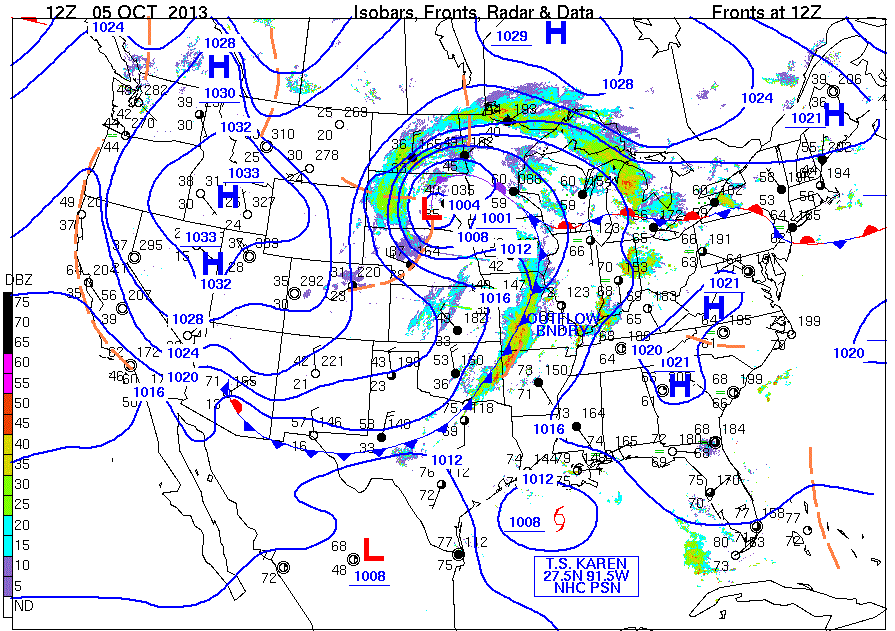AIR PRESSURE CHANGE
Objectives:
Changes in atmospheric pressure at any place on Earth’s surface occur over time as well as with distance. In midlatitudes, these changes are often related to the migration of air masses. An air mass is a huge volume of air covering thousands of square kilometers that is relatively uniform horizontally in temperature and water vapor concentration. Neighboring air masses with contrasting characteristics tend not to mix so that distinct boundaries (fronts) form between them. As the centers of air masses are high pressure centers, their separating boundaries, the fronts, occupy troughs of low pressure. As air masses travel over Earth’s surface, there are accompanying changes in the air pressure and weather at places in their paths. Those changes are particularly dramatic at or near the air mass boundaries (fronts).
After completing this investigation, you should be able to:
- Identify air pressure changes and other local weather conditions that indicate the passage of a cold front.
- Relate local air pressure changes and weather conditions to the presence of different air masses before and after the passage of a cold front.
- Estimate the speed of movement of a strong, well-defined cold front.
Introduction:
Highs (Hs) and Lows (Ls) plotted on surface weather maps identify the highest or lowest pressure centers of broad-scale pressure systems. Up to several of these might be seen on a map of the coterminous United States at any particular time. These systems generally move from west to east across our midlatitude portion of the globe. Pressure values at locations in the paths of these migrating systems fall as a Low approaches or a High departs, and pressures rise with approaching Highs or departing Lows. Fronts can mark the boundaries of these Highs and generally show the transition from one air mass to another. Fronts frequently anchor at low-pressure centers.
It should be noted that fronts are located where frontal surfaces intersect Earth’s surface. The frontal surfaces form the boundaries of “domes” of air masses.
Figure 1 is a cross-section schematic of a cold front moving from west to east. The vertical scale of the cross-section is greatly exaggerated for clarity. The warm (red) air mass is being replaced by the cold (blue) air mass. Each air mass would have a high-pressure center as shown. Imagine being located where the air pressure is highest in the warm air mass. You would find that pressure, temperature, and other weather parameters vary as the front approaches and moves past your location. (For a map view, see Figure 1 of Investigation 2A.)

Figure 1. Cross-section of idealized cold front.
1. As the cold front passes your location, the temperature where you are would [(rise)(remain steady)(fall)].
2. As the cold front moves toward and passes your location, the air pressure would typically [(rise then fall)(fall then rise)].
As directed by your course instructor, complete this investigation by either:
- Going to the Current Weather Studies link on the course website, or
- Continuing the Applications section for this investigation that immediately follows.
Investigation 5A: Applications
Over one weekend a frontal system developed across the country separating cooler air to the north from warm and humid tropical air to the south. A center of low pressure formed along this frontal system in Colorado, a favored location for storm creation to the east side of the Rocky Mountains. The eastern portion of this frontal system was stationary from the upper plains states to the East Coast. The southwestern portion of the system was a cold front. The cold air to the north and west of the low-pressure center aided heavy snowfalls while the inflow of air from the Gulf of Mexico to the southeast of the low-pressure center spawned thunderstorms with severe weather including tornadoes.
Figure 2 is the surface weather map for 12Z Friday 04 OCT 2013. The low-pressure center of the system was located within the 1004-mb isobar showing three Ls from southern Colorado to southern Nebraska. Wichita, located in southeastern Kansas, has its station model obscured by the isobar label “1004”.

Figure 2. Surface weather map for 12Z 04 OCT 2013.
3. At 12Z on 4 October, Wichita was situated with the low-pressure storm center to its west. Therefore, the frontal system [(had not yet)(had already)] passed Wichita.
Note the orange, open semicircled line across west Texas. This dryline identified a discontinuity in humidity amount. The temperatures were 71 °F at Midland, in west-central TX, and 68 °F at El Paso, in far western TX, but the dewpoint at Midland was 62 °F while El Paso’s was 43 °F, a nineteen-degree difference indicating a water vapor concentration in Midland’s air about twice the water vapor content of El Paso’s air.
Figure 3 is the meteogram for Wichita, KS (ICT) for the 24-hour period from 1200Z 04 OCT 2013 (131004/1200 in the top heading of the meteogram) to 1200Z 05 OCT 2013. Meteograms for current weather conditions for the preceding 24-hour period at selected stations can be obtained from the course website (Surface section, Meteogram for Selected Cities). All weather element graphs use the same horizontal time axis where the date/Z (UTC) time is shown. Mark the intermediate tic marks on the horizontal time axis with their values, “13” for 13Z, 15, etc. On the Figure 3 meteogram, mark the left vertical line at the position of the 04/12Z time tic as Figure 2 surface weather map time.

Figure 3. Meteogram for Wichita, KS (ICT) for the 24-hour period from 1200Z 04 OCT to 1200Z 05 OCT 2013.
4. The air pressure in millibars is shown in the bottom graph of the meteogram. From 12Z to 22Z on the 4th, the air pressure at Wichita was relatively low, rising slightly and then falling slowly. At approximately 16Z the pressure was about [(1003)(1007)(1010)] mb.
5. From 16Z until 22Z on the 4th, the air pressure generally [(fell)(remained steady)(rose)].
6. From 22Z of the 4th until 12Z on the 5th, the pressure generally [(fell)(remained steady)(rose)].
7. For the several hours preceding and then following 22Z, the pressure [(fell more slowly than it rose)(fell more rapidly than it rose)].
8. Between 22Z on the 4th and 12Z on the 5th (the end of the meteogram period), the pressure change was approximately [(6)(9)(14)] mb.
9. From the beginning of the meteogram period until 22Z, the winds were generally from the [(south)(north)(west)(east)].
10. Between the 22Z and 23Z observations, the wind at Wichita shifted to become generally from the [(south)(north)(west)(east)]. At 01Z on the 5th, the winds had become northwesterly and remained so for the rest of the meteogram period.
11. The top graph displays reported temperature and dewpoint values. From 12Z to 22Z on the 4th (7 AM to 2 PM local time), the temperature generally [(fell)(rose)] gradually. This would be expected as the normal daytime solar heating pattern.
12. However, from 22Z to 23Z of the 4th, the temperature [(fell)(remained steady)(rose)].
13. In that hour, the temperature change was about [(2)(5)(10)(20)] degrees.
Figure 4 is the surface weather map for 12Z 05 OCT 2013. On the Figure 3 meteogram, mark the right vertical line at the position of the 05/12Z time tic as Figure 4 surface weather map time.

Figure 4. Surface weather map for 12Z 05 OCT 2013.
14. Compare the temperature, dewpoint, sky cover, and sea-level air pressure at Wichita at 12Z 05 OCT 2013 from the surface weather map station model with those of the Figure 3 meteogram. These surface map values [(were)(were not)] the same as those shown in the meteogram for that same time.
15. From the cold front’s position and direction of motion indicated on the Figure 4 map, the front at 12Z [(had already)(had not yet)] passed Wichita’s location.
16. The Figure 3, 24-hour meteogram shows changes from falling to rising pressures, from rising to falling temperatures, and wind direction shifts from southerly to westerly and then northwesterly directions. These changes collectively suggest that the cold front passed Wichita between [(17 and 18Z)(22 and 23Z)(02 and 03Z)].
17. The third graph showing horizontal visibility and weather symbols reports that [(snow)(a thunderstorm)(haze)(fog)] occurred at 23Z with rain at 00Z on the 5th.
18. Compare the temperature conditions reported on the Image 2 meteogram at 12Z on the 4th with those at 12Z on the 5th. The air at Wichita was [(warmer)(colder)] on the 5th of October.
Also compare the water vapor content of the air as identified by the dewpoints. Dewpoint is a measure of the absolute amount of water vapor in air, the higher the dewpoint, the higher the water vapor concentration of the air. Air with more water vapor is typically referred to as more humid.
19. Comparing dewpoints at 12Z on the 4th with those at 12Z on the 5th. The air at Wichita was [(more)(less)] humid on the 5th. What a difference a day (and a cold front) makes!
You can acquire meteograms for the NWS station closest to you if not among those on the course website, (or to other locations around the U.S. and world) by going to: http://vortex.plymouth.edu/statlog.html (). [This is the “click here” link on the bottom of the Meteograms for Selected Cities in the U.S. page from the course website Surface data section.]